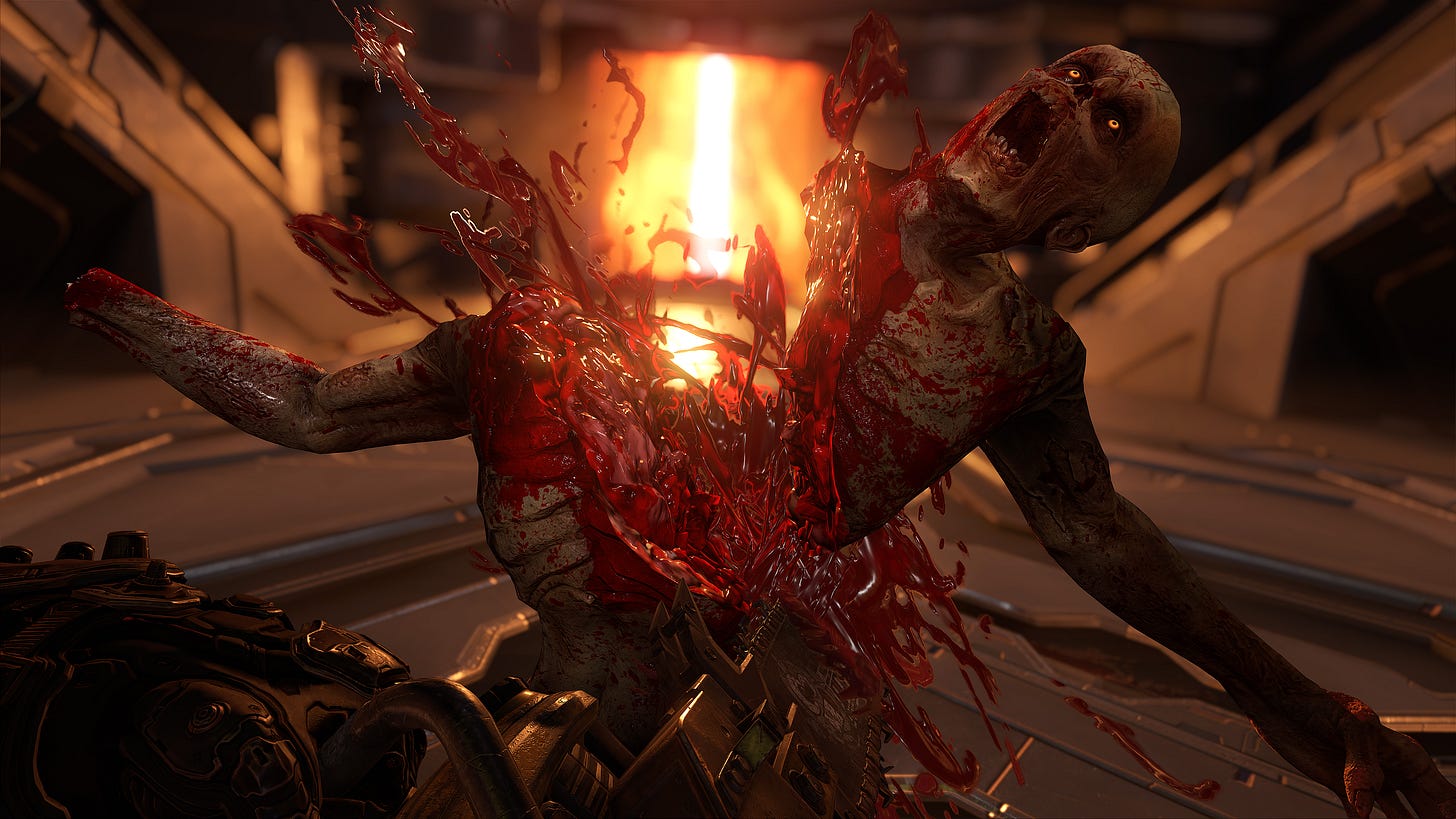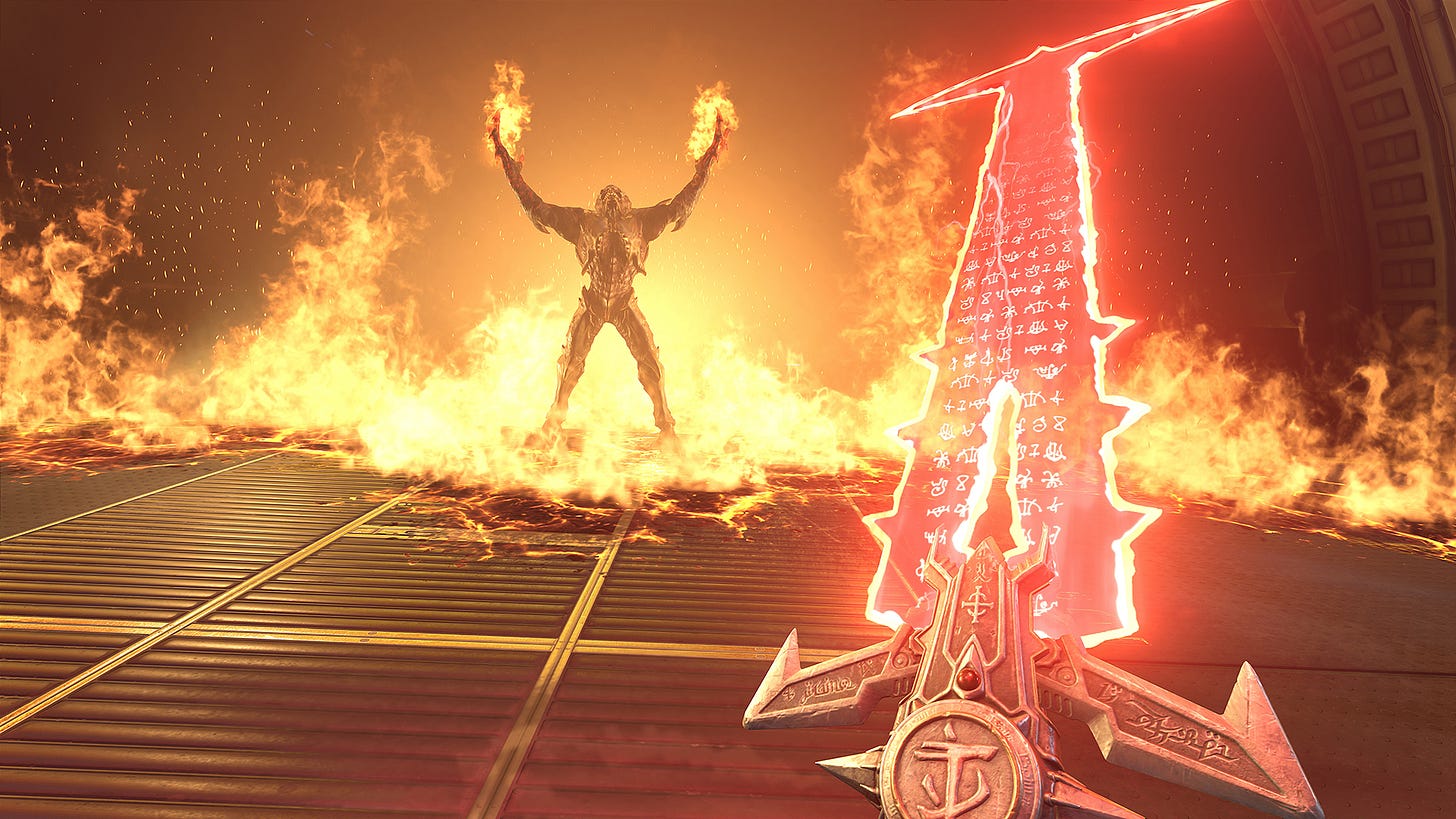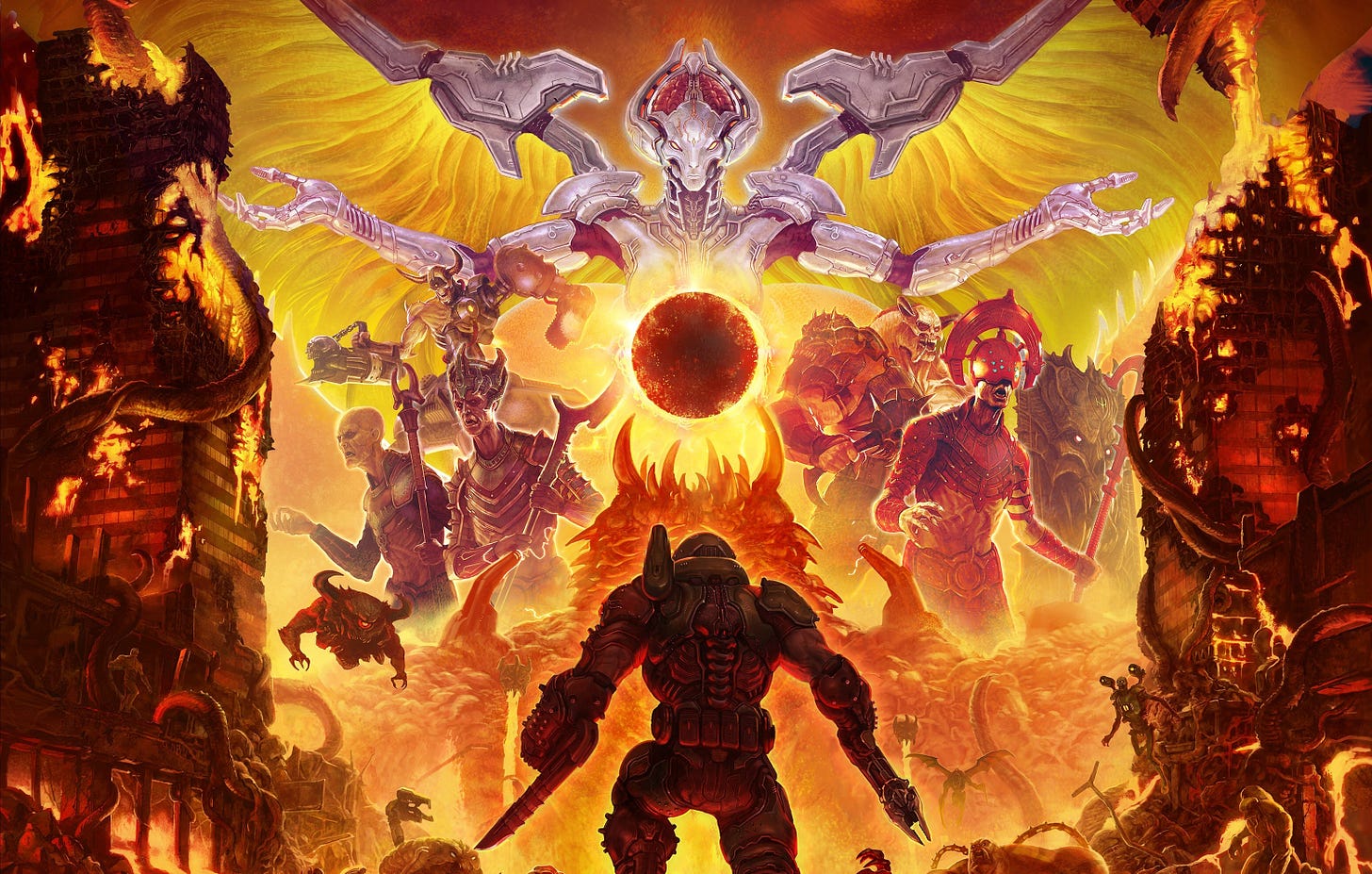Building On A Core Loop With Doomguy, With Mixed Results

Personally, I would say that one of the defining features of Doom (2016), which for convenience here I'm just going to call "Doom", is that the design of that game is tightly wound around the core combat loop. Combat is designed around a single rhythm, that of running around a combat arena, gunning down demons, a rhythm of charging in, ripping a demon apart for some health or some ammo, and backing off to release another salvo of ammunition. Everything about Doom, from the enemy design to the level design to even the narrative, is in service of this loop: back off, shoot, charge, rip and tear, repeat.
That's why I don't necessarily envy the task of having to make a sequel to Doom. That game is a perpetual motion machine of a design, one which converts movement to damage to glory kills to resources to movement, and having to expand on that framework in the way a sequel does stands two obvious risks: the feeling like anything you add will be unnecessary chaff, bolted onto the exterior of this machine, or worse, your additions might disturb the flow of that machine, breaking it in the process.
This is not to say that Doom was perfect, though, and that there was no room for improvement. The game mechanics had generally been milked for all they were worth hours before the game's climax, leaving the ending feeling a bit like it wore out its welcome. Speaking of the game's climax, in the third act the game seemed to forget that, no, I actually don't care that much about the Doom plot, please don't literally immobilize me and force me to listen to plot for five minutes.
So, with a tricky problem to solve, but definite space to improve and grow on the framework of Doom, we sit here in 2020 with Doom Eternal, technically the sixth game in the Doom series (if you count Doom 64, which Doom Eternal has surprisingly strong opinions that you should). Having just finished the game recently, I can finally answer whether or not Eternal meaningfully builds on the framework of Doom, or if it just gets in its own way in an attempt to expand for expansion's sake.
The answer is "yes". It does both.

Doom Eternal's combat loop had me grinning from ear to ear. Looking back at gameplay footage of Doom, a game praised for fast-paced, momentum driven, pulse-pounding combat, it feels positively glacial compared to Eternal. Base movement speed has been sped up, along with the addition of a quick dash, weapons shoot faster while maintaining their punchy feel, and enemies in Eternal are far more aggressive, mobbing you and forcing you to keep moving, lest you feel overwhelmed. Glory kills happen much faster (although I did have the upgrade that speeds them up equipped for most of the game, so that might skew matters, although the presence of that upgrade in Eternal is significant in its own right).
This uptick in speed is combined with a retooling of the game's resource system. Enemy corpses now serve as piñatas for health, ammo, or armor, depending on the precise way by which that enemy violently died. Maximum ammo counts have been pretty aggressively dropped, which combined with weapons' high rate of fire means you're wanting for ammo almost constantly. The aforementioned aggressive enemies create a similar strain on health and armor. The rhythm that was in Doom is here, but magnified in speed. You're always running away from threats and damage, and running towards your next target, in hopes of immolating, eviscerating, or exploding them to get whatever resource you need next. You isolate a target and burn them down whilst trying to avoid everyone else actively trying to kill you. You are always predator and prey, simultaneously.
The retooled chainsaw, an insta-kill weapon which causes enemies to spill bullets like a leaking Cabela's, deserves special mention. The chainsaw in Doom was a sort of last-ditch effort, a weapon you really only used in an absolute pinch, frequently either to save you from running completely out of ammo, or to wipe out an enemy that poses too great a threat. Eternal has repositioned the chainsaw to be your primary source of ammo, granting you a regenerating point of fuel for it, ensuring you always have it available, in exchange for requiring more than that single point of fuel for enemies stronger than your basic fodder.
Doing this directly correlates with the game's momentum, and the feeling of aggression promoted via the mechanics. Combat encounters are always filled with fodder enemies (they don't stop respawning until you kill the quote-unquote "real" enemies), many of whom, like the Imp or Gargoyle, add to the constant cacophony of attacks the player must either dodge or endure. The incentive to use the chainsaw is great, it removes a source of damage from play, however temporarily, and replenishes ammo. The chainsaw is always a good move; you don't risk running out of ammo, and there's always something to chainsaw. These two factors push the player to chainsaw constantly, which ensures the player constantly gets the dopamine hit of eliminating enemies, violently at that. The chainsawing of fodder enemies creates a sort of "background violence" to Doom Eternal, a feeling that even that time spent evading larger threats is still time in which you are on the attack. Simply put, the chainsaw ensures that, even in fights with late-game enemies who can endure hundreds of bullets (not an exaggeration), the player never goes more than a few moments without killing something.
So, the combat has been expanded while still maintaining a constant sense of speed and violence, making the player make interesting decisions in combat due to a rhythmic pace forcing the player to context switch between defense and attack (or, perhaps more accurately for Doom Eternal, attack and ballsier attack). How do the rest of the additions fare?
Well...

Let's take a step back and talk about the Doom Slayer, or Doom Guy, as a character. Even still, this sentence is kind of funny: the Doom Guy of the original Doom games is a blank slate, a void of personality, essentially a shotgun on legs. Doom, this is again 2016 Doom, knew this, and in building out the setting and lore of the world actually maintained the Doom Slayer (as he had been renamed) as a sort of elemental of violence, a storm more than a person. Sure, other characters would go on about cults and gods and the energy crisis and the good of mankind, but the Doom Slayer, both within the narrative and through the actions of the player, existed purely to rend demons. Every action he took was done, either in part or in totality, because it let the Doom Slayer kill more demons.
Doom Eternal attempts to massively expand upon the setting of Doom, establishing cosmological hierarchies, factions within the setting, and most notably, an origin and personality for the Doom Slayer, which isn't fundamentally bad, but the execution absolutely erases the Doom Slayer's established nature. Establishing this setting requires characters to explain this setting, and doing so requires the Doom Slayer to patiently wait while characters explain their dark schemes, in one case causing enemies directly responsible for the invasion of Earth by Hell to get away because Doom Guy gave them a chance to talk.
Now, I don't really care about the integrity of the character of the Doom Slayer, as far as I care from a narrative perspective they can retcon him into a 67 year old Italian man named Giuseppe who kills demons to raise money for his struggling turnip farm, I absolutely do not care. The problem with the recharacterization is that the Doom Slayer was designed such that it framed the plot of Doom in such a way that it tied with the game's mechanical loop instead of against it. In gameplay and out of it, the Doom Slayer existed to murder demons. Everything else felt like it was in service to that goal, and in this the game had a consistent tone and a clarity of purpose.
Eternal's rework of the Doom Slayer character muddles that tone, meaning there are times in the game where you, the player, want to go kill demons, but the game, and now the Doom Slayer, want to do something else. Enemies will appear, including an early appearance by what ends up being the game's antagonist, and the player's mind is thinking "KILL. I WANT TO KILL THAT", but the Doom Slayer is content to patiently listen to her admonishment, and a disconnect is born.
Less important but still annoying, a lot of the peripheral character building with regards to the Doom Slayer demotes him even further. Imagining the Doom Slayer meticulously arranging his off-brand Funko Pops on his shelves, or smacking himself in the head as he practices with his nunchucks (which are visible in his home office, right next to his gaming PC) contrasts the Doom Slayer as Warrior King and Violence Incarnate with the Doom Slayer, Someone's Lame Uncle. I get strong "present-day Stephen Seagal" vibes from this Doom Slayer.
Mechanically speaking, the additions to things other than combat are also pretty weak. The pacing between fights is dragged to a crawl by a new emphasis on first-person platforming, which admittedly is better than it usually is. However, these platforming sections aren't really lack any sense of mastery of the controls or a push towards exploration (the path is usually very obvious), meaning they just sort of take time. Bizarrely, these sections are devoid of enemies, and while I spent the entire game expecting a moment where I would have to successfully platform while in combat, the closest the game ever got was one switch you need to shoot mid-flight. Because of this, it's hard to not feel about the game as "the part I came here for" (the combat) and "this other stuff" (platforming).
Here, I think, is a lesson. Doom was a machine, single-minded in purpose. In adding these platforming sections to the game, Eternal is spending valuable time in its levels pulling the player away from The Thing They Came To Doom To Do (the slogan is "Rip and Tear", not "Rip and Tear and then Grab Onto This Wall so you can Reach This Monkey Bar"). I hypothesize this would have proven far less intrusive had the platforming section been more closely integrated with combat (simply adding some enemies to the platforming areas would be a start, although I suspect the current form of the platforming mechanics would be a little clumsy to try and balance with a combat encounter), or to build up this part of the game into something worth focusing on.
Other shooters, especially Titanfall 2, have pulled off this "combat-movement dichotomy" better, mainly by one, ensuring that the platforming sections were just as dynamic, action-packed, and exciting as combat, and two, ensuring there was a relatively high skill ceiling to the movement abilities available to the player. Titanfall's wall running was hard, it required timing and a good sense of momentum, which compounded with levels that required you to wall-run in increasingly elaborate and interesting situations. Moreover, this mobility is deeply tied to the combat of Titanfall 2, and even in the fiercest firefights (at least, while on foot), you will be wallrunning, jumping, crouch sliding, and using all of the movement mechanics to their fullest.
Doom Eternal's mobility mechanics mostly require you to find a climbable wall, jump to it, look for the next climbable wall, jump to it, ad infinitum, from the first level to the last. Other than "sometimes platforms fall", this mechanic is never built upon, and never truly challenging. As previously mentioned, the new dash is heavily utilized in combat simply in the need to maintain speed, but the other mobility mechanics introduced, including climbable walls and monkey bars, exist only as vestigial appendages to combat arenas, pieces of level design I noticed frequently, but never needed.
One time I saw a climbable wall in an arena in the midst of a fierce firefight, and I said, out loud, to my empty apartment, "why the fuck would I use that right now".
I'm nitpicking all of this only because the beauty of Doom were the moments where all aspects of the game all fed into the same core idea of "rip and tear". When the combat gameplay, the soundtrack, the level design, the narrative, and the character were all in harmony, all screaming at you "RIP THEIR GUTS OUT", it feels incredible. When Eternal hits those same notes, it brings out even higher highs. Looking back at old footage of Doom, I was surprised how incredibly slow it looked for a game I remembered as pulse-poundingly fast, which is a testament to the incredible sense of speed Eternal builds, when it wants to (which, admittedly, is frequently).
Unfortunately, my praise for Eternal cannot come without similar bemoaning of the lack of focus, the moments where the game tears me (heh) from what I want to do, which is visceral murder, so I can look at some hot new Doomguy backstory or do some platforming. These attempts to build onto the core loop of Doom instead feel vestigial, like in some version of this game they might have been cool, had they more tightly embraced that core beating heart of Doom Eternal, but instead I just wish someone would take a chainsaw to them and carve them off of my great game.